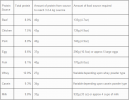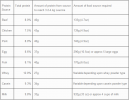Kenny Croxdale
Level 7 Valued Member
This is interesting stuff. I've sent you some research on it
Protein Pulsing
This has to do the Refractory Period in Muscle Protein Synthesis.
The Refractory Period meal timing is similar to a sponge.
When the sponge is dry it soaks up more water.
When the sponge is wet, very little water is soaked up.
The sponge needs to be allowed to dry out before it can optimally absorb the greatest amount of water. This is The Refractory Period that ensures that the maximal amount of water is absored.
The Refractory Time Period requied for optimal Muscle Protein Synthesis for the anabolic process occurs the same way.
The Muscle Protein Synthesis Refractory Period
Research (Drs. Layne Norton and Gabe Wilson, Nutrition PhDs) demonstrated that The Refractory Period for Maximal Muslce Protein Synthesis after a meal is between 4-6 hours. When a meals are consumed in that time period, Muscle Protein Synthesis is Maximized (greater muscle building takes place).
The Bodybuilding Eat Protein Every Three Hours
This method has no scientific foundation. The research demonstrated that consuming a protein meals every three hours amounts to trying to wipe of water with a sponge that is still fairly wet.
Thus, the Eat Protein Every Three Hours limits the optimum Muscle Protein Synthesis, anabolic process.
Increasing Muscle Protein Synthesis Between Meals
Based on Dr. Layne Norton's hypothesis, Muscle Protein Synthesis may be spiked between high protein meals with BCAA's or Leucine alone. BCAAs or Leucine enters the system and exit it quickly. It spikes mTOR, the anabolic trigger.
As per Norton, around two hour after a high protein meal and about two hour prior to the next high protein meal, BCAA's or Leucine appear trigger mTOR.
A few articles have recommended, Protein Pulsing around 4 hour after a high protein meal "Catches the Muscle Protein Synthesis Wave" at the right time; "Timing is everything".
The articles recommended taking a the quickly digested whole Whey Protein. Whey is considered as the "Anabolic Protein", due to the fact that it enters the system and exits the system so quickly.
Hydrolyzed Whey enters the system the fastest; in approximately 20 minutes. That because it is composed of di and tri peptides that are absorbed quickly.
The problems with Hydrolyzed Whey is that it taste like crap and the cost.
Pulse Feeding
Reseach shows Muscle Protein Syntheis for older individual is more effective with this method. Up to 70% of daily protein intake is consumed in a meal.
Older individuals system are not as efficient as younger individuals. Thus, for older individual to obtain a similar Muscle Protein Synthesis effect, the amount of protein per meal is greater.
This is a good article on Pulse Feeding.
The test subjects in the Université Paris-Descartes experiment didn't train with weights, they didn't take supplements or illegal anabolic substances, and they didn't eat much protein either – yet they built up more muscle mass. All they did was to consume seventy percent of their daily protein allowance during one meal. Protein pulse diets have an anabolic effect.
Two Meals A Day
That is what I am doing. That based on...
1) Breakfast
After having a breakfast of 1,000 to 1,400 kcal; 55 to 70 grams of Protein and 90-100 gram of Fat, I am not hungry for lunch. Duh!
2) Pulse Feeding
Since I am in the older category, it makes sense to have less frequent high protein meals.
Since I am on Keto, that means my Fat intake is high as well. My Fat intake for a meal is usually 70% of my Macros. Protein is around 20% to 25%.
3) Protein Pulsing
Between those two meal, approximately 4 hours after Breakfast and 4 hours before Dinner, I have Leucine.
Protein Pulsing
This has to do the Refractory Period in Muscle Protein Synthesis.
The Refractory Period meal timing is similar to a sponge.
When the sponge is dry it soaks up more water.
When the sponge is wet, very little water is soaked up.
The sponge needs to be allowed to dry out before it can optimally absorb the greatest amount of water. This is The Refractory Period that ensures that the maximal amount of water is absored.
The Refractory Time Period requied for optimal Muscle Protein Synthesis for the anabolic process occurs the same way.
The Muscle Protein Synthesis Refractory Period
Research (Drs. Layne Norton and Gabe Wilson, Nutrition PhDs) demonstrated that The Refractory Period for Maximal Muslce Protein Synthesis after a meal is between 4-6 hours. When a meals are consumed in that time period, Muscle Protein Synthesis is Maximized (greater muscle building takes place).
The Bodybuilding Eat Protein Every Three Hours
This method has no scientific foundation. The research demonstrated that consuming a protein meals every three hours amounts to trying to wipe of water with a sponge that is still fairly wet.
Thus, the Eat Protein Every Three Hours limits the optimum Muscle Protein Synthesis, anabolic process.
Increasing Muscle Protein Synthesis Between Meals
Based on Dr. Layne Norton's hypothesis, Muscle Protein Synthesis may be spiked between high protein meals with BCAA's or Leucine alone. BCAAs or Leucine enters the system and exit it quickly. It spikes mTOR, the anabolic trigger.
As per Norton, around two hour after a high protein meal and about two hour prior to the next high protein meal, BCAA's or Leucine appear trigger mTOR.
A few articles have recommended, Protein Pulsing around 4 hour after a high protein meal "Catches the Muscle Protein Synthesis Wave" at the right time; "Timing is everything".
The articles recommended taking a the quickly digested whole Whey Protein. Whey is considered as the "Anabolic Protein", due to the fact that it enters the system and exits the system so quickly.
Hydrolyzed Whey enters the system the fastest; in approximately 20 minutes. That because it is composed of di and tri peptides that are absorbed quickly.
The problems with Hydrolyzed Whey is that it taste like crap and the cost.
Pulse Feeding
Reseach shows Muscle Protein Syntheis for older individual is more effective with this method. Up to 70% of daily protein intake is consumed in a meal.
Older individuals system are not as efficient as younger individuals. Thus, for older individual to obtain a similar Muscle Protein Synthesis effect, the amount of protein per meal is greater.
Human study: protein pulse gives anabolic stimulus
The test subjects in the Université Paris-Descartes experiment didn't train with weights, they didn't take supplements or illegal anabolic substances, and they didn't eat much protein either – yet they built up more muscle mass. All they did was to consume seventy percent of their daily protein...
www.ergo-log.com
This is a good article on Pulse Feeding.
The test subjects in the Université Paris-Descartes experiment didn't train with weights, they didn't take supplements or illegal anabolic substances, and they didn't eat much protein either – yet they built up more muscle mass. All they did was to consume seventy percent of their daily protein allowance during one meal. Protein pulse diets have an anabolic effect.
Two Meals A Day
That is what I am doing. That based on...
1) Breakfast
After having a breakfast of 1,000 to 1,400 kcal; 55 to 70 grams of Protein and 90-100 gram of Fat, I am not hungry for lunch. Duh!
2) Pulse Feeding
Since I am in the older category, it makes sense to have less frequent high protein meals.
Since I am on Keto, that means my Fat intake is high as well. My Fat intake for a meal is usually 70% of my Macros. Protein is around 20% to 25%.
3) Protein Pulsing
Between those two meal, approximately 4 hours after Breakfast and 4 hours before Dinner, I have Leucine.
Last edited:


